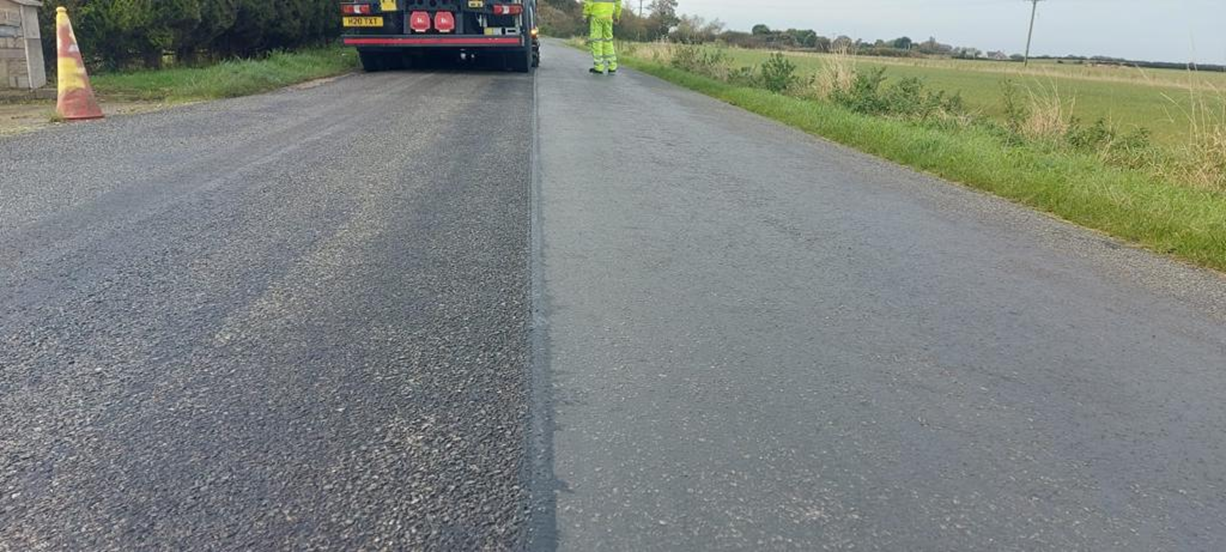

Leigh Foster, Regional Specification Manager at WJ, discusses the road safety issues caused by bitumen bleed – and why hydro retexturing is the ideal solution
Join other savvy professionals just like you at CIHT. We are committed to fulfilling your professional development needs throughout your career
It is no secret that our summers are getting hotter. In the last five years alone, the UK has experienced three of its ten hottest years since records began in 1884, with the record-high of 40.3°C coming in July 2022 .
One of the many areas impacted by rising temperatures is the road surface itself. Being dark in colour, roads tend to absorb and retain heat, potentially being 20°C to 30°C hotter than the air temperature, with surface temperatures recently exceeding well over 60°C in the UK. Bitumen, a key component in road surfaces, softens under high temperatures. When this happens, it can rise or ‘bleed’ to the surface, especially under the pressure of passing traffic, which pushes the aggregate into the softened binder.
The result is a thin layer of bitumen sitting on the surface. In hot weather, it can stick to vehicles, and when conditions cool or it begins to rain, this layer hardens and becomes slick, significantly increasing braking distances and the possibility for skidding incidents, posing serious safety risks for all road users.

A challenge with bituminous road surfaces in certain circumstances is bitumen bleed, where excess binder rises to the surface under heat and traffic. This can restrict the use of further surface treatment systems that are cost and carbon friendly and are an excellent way to extend road life, improve skid resistance, and protect against water ingress.
This is where hydro retexturing proves highly effective. The process uses high-pressure water to remove the surplus bitumen and restore both macro and micro texture.
Instead of adding new material, it reinstates the texture depth and exposes the existing high-quality aggregate. The process is precise, contained, and allows roads to remain open under traffic management causing minimal disruption.
Retexturing not only makes roads safer immediately but also prepares the surface for new treatments such as surface dressing. By combining treatments in this way, asset managers can extend road lifespan, reduce the need for costly resurfacing, and maximise the value of previous works, all while delivering a durable, low-carbon solution.
Unlike most road surface treatments that rely on ideal weather conditions and operate in the summer season, hydro retexturing is suitable for almost any weather condition, although it performs best in cooler temperatures when the bitumen is more brittle.
This approach not only alleviates safety concerns year-round but also reduces disruption to motorists. This is both because it is a quick and simple process to a member of the public, it looks similar to a street sweeping machine – and because the entire road doesn’t need to be treated, can be done in a single pass.
Hydro retexturing can be even more cost-effective because it can avoid the need for full width road treatments, targeting only the wheel tracks where bitumen bleed is likely to be more pronounced in a quick, efficient single pass. This dramatically reduces the time taken, energy consumption, and vehicle emissions, giving it a much lower carbon footprint than traditional methods.
Staffordshire County Council had been trying to address the problem of bitumen bleed across its 6,000km of roads for years, before it adopted a programme of hydro retexturing to address the problem.
The council and its maintenance partner Amey engaged WJ Group to deliver a hydro retexturing programme, and saw a set of outstanding results that stand as a testament to the effectiveness of the solution. These included an area of 89,589m² retextured in just five years, resulting in cost and carbon savings of 90% and 976.52tCO₂e (96%) respectively compared to resurfacing.
This demonstrates how local authorities can deliver effective and efficient solutions that improve safety, lower costs, and reduce carbon, with hydro retexturing serving as a prime example of this in relation to the problem of bitumen bleeding.
The road safety problems caused by high temperatures are not going away, with the UK government now estimating that the chance of 40°C temperatures is ten times more likely than it was in the past . In light of this, and the financial constraints that many councils have to operate under, there is no better solution to the problem of bitumen bleeding than hydro retexturing.
As the largest surface retexturing provider in the UK, WJ Group offers a choice of surface retexturing techniques to suit the substrate condition and the client’s objectives.
>>> Find out more
WJ Group is the UK’s leading road marking and highway safety business, supporting high speed, local authority and off-highway markets by providing solutions that create safe, sustainable journeys for everyone. We specialise in Road Markings, Studs, Safety Surfacing, Retexturing, Surface Defect Repairs, TASCAR, CCTV, Stopped Vehicle Detection and other ITS solutions.
Join other savvy professionals just like you at CIHT. We are committed to fulfilling your professional development needs throughout your career
{{item.AuthorName}} {{item.AuthorName}} says on {{item.DateFormattedString}}: